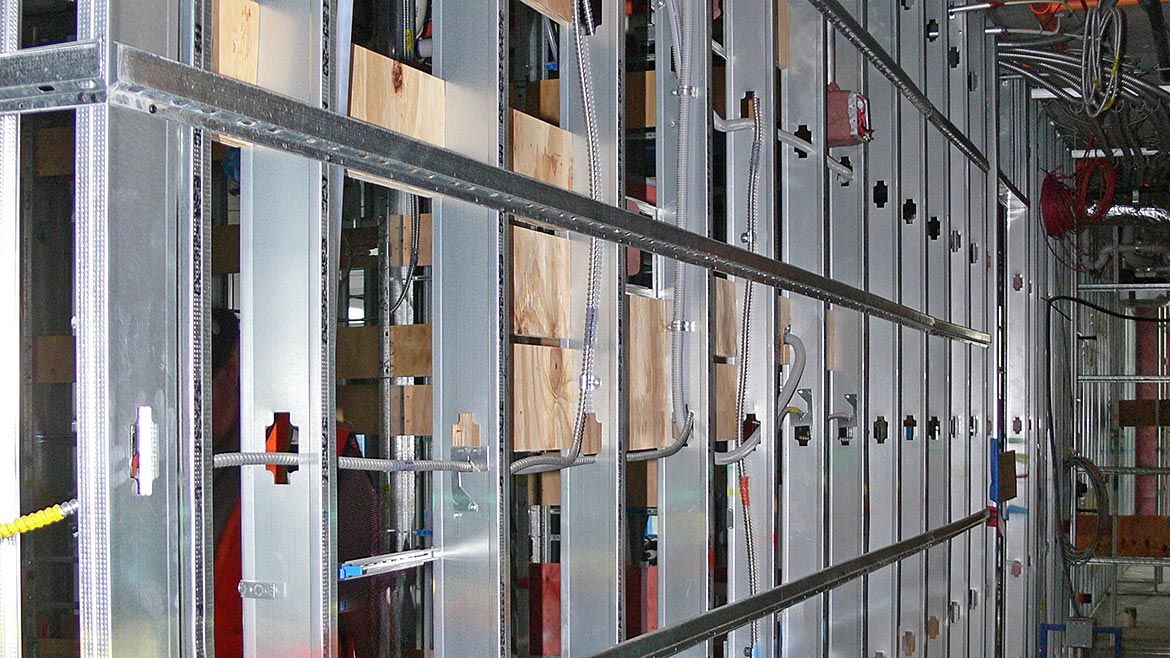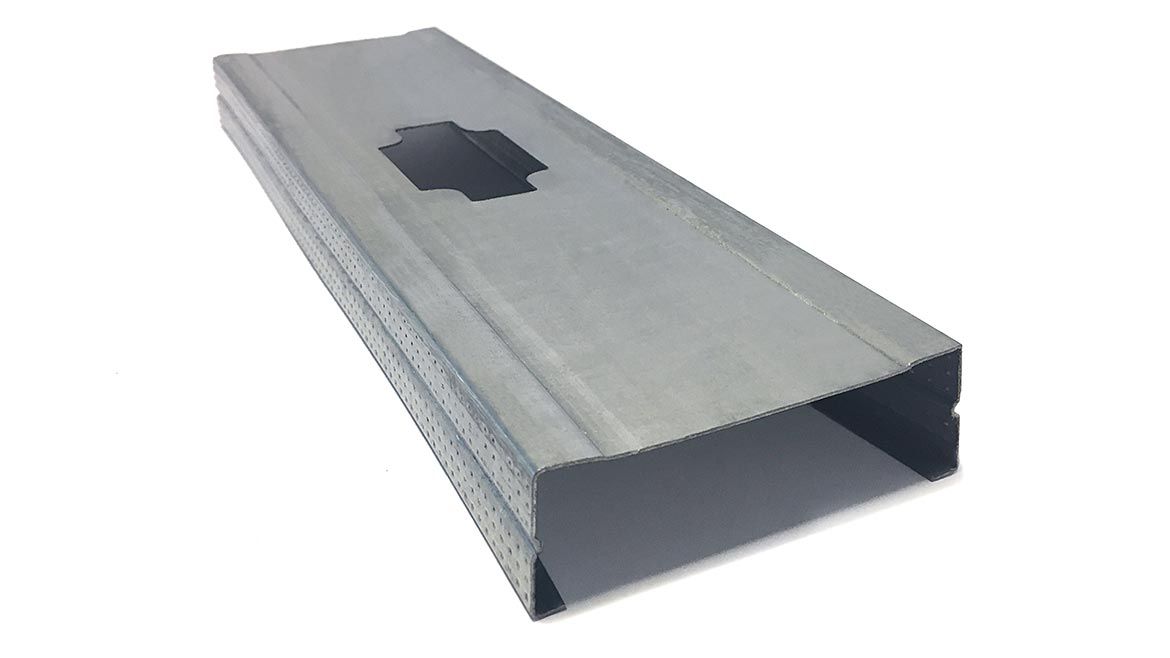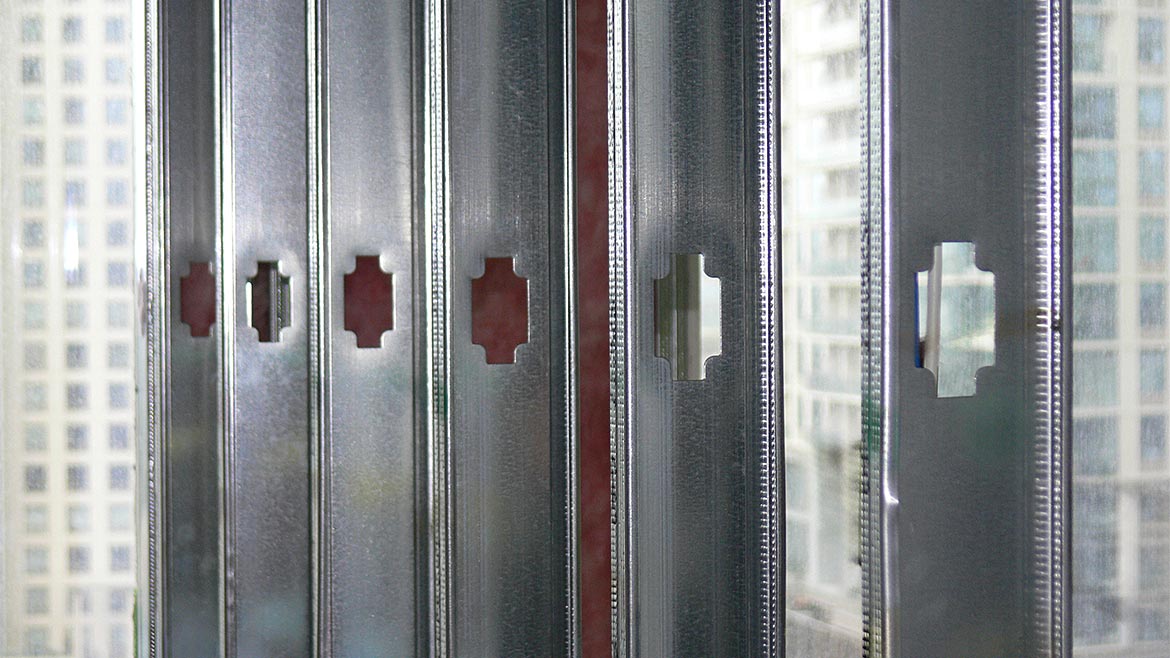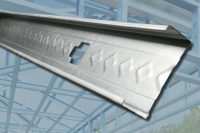Introduction
Cold-formed steel non-structural stud and track members are formed from a formulation of iron ore and other chemicals, creating steel that has gone through a forming process, cold reduced into a specific specification and roll-formed into a final cold-formed C-shaped member.
The steel is produced to meet specific steel types of different mechanical and chemical specification, design thickness, minimum thickness, yield and tensile strength, and protective coating, in compliance with the appropriate codes and ASTM and AISI industry standards for cold-formed steel members.
The members are roll-formed into the desired shapes in compliance with the AISI S100 Standard—Specification for Design of Cold-Formed Steel Members, producing individual cold-formed steel members with different mechanical, physical and structural properties.
The development of all types of EQ cold-formed steel stud and track members, regardless of their profile and proprietary properties, meet the same standards and are formed using the same production process.
History of the Development of the Non-Structural Cold-Formed Steel EQ Member
Prior to the 1990s, non-structural cold-formed steel studs were designed using the actual dimensions, proprietary profile and gauge steel design thickness, using the gross and net properties for CFS member identification.
In the 1990s, the method of generating CFS member generic and proprietary properties and capacity changed in accordance with the AISI Standard Specification for Design of Cold-Formed Steel Members by using the actual specific decimal steel thickness, not a gauge thickness range. The cold-formed steel member is identified by using the effective structural properties generated using an iteration process. In addition, the introduction of applying cold work of forming resulted in stress and properties modification.
The ASTM C645 Standard for Non-Structural CFS Members defined the non-structural member as having a minimum uncoated steel thickness of 0.0179 inches (which is 95 percent of a 0.0188-inch design thickness) and meeting the section properties set forth in the standard. Included was a minimum protective coating of G40 or equivalent.
In the mid-1990s, ICBO ES developed code compliance and acceptance criteria, including AC86—Acceptance Criteria for Cold-Formed Steel Framing Members - Interior Non-Load-Bearing Wall Assemblies. The criteria set the protocol for limiting heights testing for composite wall heights.
In 2000, the cold-formed steel industry decided to standardize the CFS identification method and profile and introduced “mil” steel thickness, dropping “gauge” as the thickness. The AISI S202 Product Data document was developed for the standardization of cold-formed steel members. However, 20-plus years later, some still refer to the steel thickness by gauge.
Manufacturers introduced proprietary stud members produced from steel thickness less than defined in industry standard ASTM C645, of minimum 0.0179 inches, non-recognized standard yield strength steel and non-conventional proprietary profiles.
The Equivalency “EQ” Stud concept was introduced to the industry, accepting a steel thickness less than the minimum 0.0179 inches. Refer to Table 1 for a list of mil steel thicknesses and the “EQ” equivalency.
The proprietary EQ stud identification is different from the conventional steel stud. Each manufacturer identifies their EQ studs with the same conventional format but with different product-specific call-out letters.
The term Equivalency “EQ” is accepted to mean equivalency in performance to the existing composite interior gypsum wall partition heights recognized by the code published in ASTM C754. EQ heights are only applicable to non-structural members defined in ASTM C645 and current AISI S220 standards.
The concept of Equivalent in Performance was accepted by the industry and adopted in ASTM C645, Section 9.2. Adoption of the ICBO ES AC86 test requirements for composite wall heights and compliance with the composite wall heights in ASTM C754 are the basis of justification for the acceptance of the EQ studs.
Each individual proprietary EQ Stud allowable composite height is derived by performing tests in accordance with AC86 acceptance criteria.
In 2015, AISI S916-2015 Test Standard For Cold-Formed Steel Framing Non-Structural Interior Partition Walls with Gypsum Board was developed from ICC ES Acceptance Criteria AC86 (Composite Wall Testing of Non-Structural Drywall Studs). It was also adopted and referenced in AISI S220 (North American Standard for Cold-Formed Steel Framing-Non-Structural Members) as a test protocol under Section 2211 of the 2018 and 2021 IBC and CBC.



The Composite Wall Height Test for the Recognition of the EQ Stud Consists of:
The composite wall height only pertains to the assembly described as tested.
- Both EQ stud flanges must be fully braced with sheathing material mechanically fastened at full wall height.
- The sheathing material must be mechanically fastened to the EQ wall-framing member to contribute to the wall stiffness and result in greater wall allowable composite height.
- The contribution in stiffened, strength and end reaction to the composite walls is determined by testing in accordance with AC86, as adopted by ASTM C645’s minimum specification for non-structural members, and conforms to the limiting heights in ASTM C754.
- Allowable composite wall heights are valid only when the wall assembly is constructed in accordance, as described in the tested wall assembly. Refer to the individual manufacturer composite wall height footnotes for installation limitations to the EQ stud assembly.
- An increase in the construction of interior composite wall partitions with top deflection tracks has increased the demand to develop composite height tables with EQ studs using different top track members, such as deflection top tracks.
One should be aware that throughout the years, the term “EQ” has been used as a common proprietary product name and not the “EQ” equivalent term definition in accordance with the qualifying testing requirements.
The Difference between the EQ Stud and the Conventional Non-Structural Stud is the Following:
The EQ stud is produced from a specific steel thickness (varies per manufacturer) less than the conventional minimum steel thickness of 0.0188 inches (20 gauge), as specified for non-structural studs recognized in ASTM C645, AISI S220, and building codes and adopted standards. The EQ stud’s specified minimum steel thickness is the actual steel thickness used and not the thickness of equivalent performance.
As an example, a 20 EQ, 18-mil (0.0188-inch) minimum steel thickness stud is equivalent in performance to a conventional 30-mil (20-gauge) steel stud. The steel thickness of the 18-mil product (0.0188 inches) is not equivalent to a conventional 30-mil (0.0296-inch), 20-gauge steel stud and should never be recognized as equivalent in thickness, as demonstrated in Table 1.
The EQ stud yield strength is greater than the standard 33 ksi used in the conventional non-structural standard stud. Yield-strength steel, such as 54 ksi, 70 ksi and greater, are used to improve the EQ stud performance.
The EQ member has a proprietary profile normally designed to maximize its capacity by adding stiffeners, ribs, embossment, knurling and change in dimensions, in addition to the mechanical changes noted above. The shape and dimension of the member is normally not the same as the generic conventional non-structural member, which has a flat web, flange and return lip.
The EQ stud concept is accepted and approved by the industry for proprietary profile and specification of cold-formed steel members, provided the standard provisions are only applied to:
- An EQ or conventional non-structural steel framing member. The concept is not applicable to structural steel framing members.
- It has been tested in accordance with AC86 or AISI S916, demonstrating performance in comparison to conventional 18 mil, 30 mil or 33 mil composite stud heights published in ASTM C754.
- Have test report supporting data for composite wall heights based on tests in accordance with AC86.
TABLE 1
Non-Structural Member Steel Thickness Conversion Table
Note:
1. Refer steel thickness by Mil thickness NOT gauge or EQ
2. EQ studs are proprietary studs
3. Mil steel thickness varies by manufacturer.
Development of Load Capacities for EQ Non-Structural Studs
EQ studs are non-structural members and therefore are recognized as having no vertical axial load capability. They are tested in accordance with ICC ES AC86 or more current S916-15 to determine the flexural strength, bending stiffness and end capacity (web stiffening). The test protocol requires each wall assembly to be tested in triplicate for the shortest and tallest wall height anticipated. The test results is a better representation of the wall performance for the specific wall thickness and specification.
Limiting Height
An example of the allowable height comparison between a proprietary EQ stud having a different profile, steel thickness and steel yield strength and a conventional stud is shown in Table 2. The difference in allowable height is demonstrated in Table 2 for a 3 5/8-inch and 6-inch-wide proprietary 20 EQ stud of 0.019-inch steel thickness with a conventional 18-mil stud of 0.0188-inch steel thickness. When identifying a specific EQ stud, it is important the EQ stud member be identified in mil thickness.
TABLE 2
20 EQ vs Conventional 3 5/8-Inch Stud Allowable Heights
20 EQ vs Conventional 6-Inch Stud Allowable Heights
Test Results
The allowable composite heights are based on the governing test results for each proprietary EQ stud. The results in the allowable composite height table demonstrate the advantage of using non-structural steel EQ steel stud members in comparison to conventional non-structural steel studs when tested under the allowable test provision. The composite wall heights are only applicable when the EQ stud wall is constructed in accordance with the wall assembly described in the test performed. Each proprietary EQ stud wall assembly will have different composite allowable wall heights. The published edition of the test standard used can also affect the results of the composite EQ wall, resulting in a difference in wall performance.
Summary
The “EQ” stud has become a common stud name that represents any proprietary non-structural cold- formed steel member that has a steel thickness less than the industry standard. Mil thickness should be used to identify the specific EQ stud being specified. It cannot be used to specify a generic stud member. EQ studs are proprietary studs that have different performance capacities. The composite wall height of an EQ stud will vary depending on the composition of the tested assembly. Large amounts of non-structural wall partitions are currently using top deflection tracks and affect the composite wall height performance of the current EQ Stud assembly.






Report Abusive Comment